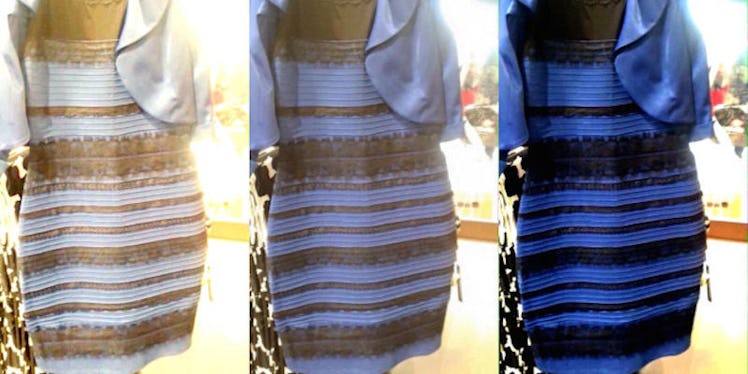
What One Dress Can Teach Us About Starting A Revolution
Last night, a dress broke the Internet and I think we’re all still trying to figure out why.
I saw it before it became a thing. I saw a post on my Facebook that asked people to vote on what color a dress was. “Hm, weird,” I thought. "It’s white and gold — isn’t it?"
I clicked on the post and then saw that the vote was split between white and gold, and blue and black. “Lol,” I thought to myself, “strange.”
And that was that. I left my computer to go to my friend’s house and promptly forgot all about the color-changing dress that suffered from an identity crisis. It was a funny post, but that was all.
Apparently, I was wrong. Hours later, I logged on to Facebook and was taken aback. Literally everyone was posting about the dress.
I scrolled through my feed to see pictures of the dress and also random statuses commenting on the now apparent Internet sensation. My Facebook was abuzz with witty commentary:
“A tacky dress just broke the entire Internet.”
“Team Blue and Black.”
“American Horror Story: Dress.”
“Get this dress the f*ck out of my life.”
Indeed, for whatever reason, this whatever-color-it-is dress had become a part of all of our lives for that moment.
Countless publications covered it, people everywhere were in on the debate and science was busy debunking it. Thursday went from a typical night to a search to find the truth about what color a dress was.
When I woke up this morning, no one was over it. The Facebook statuses were still coming in, growing more ridiculous as time passed:
“What dress?? I just see a little old man in a rocking chair. Do you guys not see him?!”
“And on the 5th day, God said ‘Let all men and women, made in my divine image, argue over the color of a dress.’ And behold, it was good.”
“The dress does not exist. The Internet is over, everybody go home.”
The dress was getting radio coverage scientists begun to confirm the truth: the dress is black and blue.
The original owner of the dress posted more pictures and yes, there we go, it's black and blue. Whoops. Everyone who thought it was gold and white is dumbfounded. At least now we know.
And now that we do know, we might all forget about it, or maybe, the buzz will continue on for a while.
Who knows? Regardless, somehow, we all suddenly care a whole lot about a dress that isn’t even ours.
So, what can we learn from the night a dress started a revolution?
People try to start movements every day. They want you to care about the rainforest and the homeless and orcas and climate change and cancer and everything.
There is always a cause and people who want you to pay attention to it. These causes are all important, of course.
And yet, an argument about what color a dress is — something that is super unimportant — got more attention in a few hours than a lot of these causes get, well, ever.
Why?
What did the dress do right?
Perhaps, people cared about the dress because it didn’t take itself too seriously.
With “movements” like "the dress" and that time a guy raised thousands of dollars to make potato salad, people have something into which they can invest their time without having to care too hard.
The cause at hand isn’t trying to make them feel guilty or save lives before midnight. It’s just being honest and even kind of silly.
It gives people something on which to feel united that doesn’t include the potential to tear them apart again later, the way big issues often do. You could say it's a form of escapism.
What if people trying to start real movements for real causes to raise awareness tried to mimic "the dress" and potato salad guy?
It's sort of how the ALS Ice Bucket Challenge worked; someone tried to raise awareness through something silly and seemingly harmless in which people could participate.
I mean, if a dress can do it, surely something that actually has the potential to shape the world can do it too, right?
We shouldn’t have to sugarcoat topics to get people’s attention. But, if we really want people to open their eyes and jump on board, maybe we need to take a look at what types of things have already successfully done so.
Maybe, there really is a lot we can learn from a dress.
What we’ve learned from this great dress debate is that ultimately, it’s not that hard to start a movement.
This is not the first time something ridiculous has captured the attention of the Internet; the Internet is very good at starting movements.
People want the chance to get involved and weigh in with their opinions. They want the chance to showcase their wit with clever Facebook statuses. It is possible to get people to care.
If nothing else, the dress got people talking to one another, debating and discussing.
Conversations are the first step toward change. If we can get these kinds of conversations started about real world issues — even if they have to start from something small and silly — then I think we’ll be on the right track.